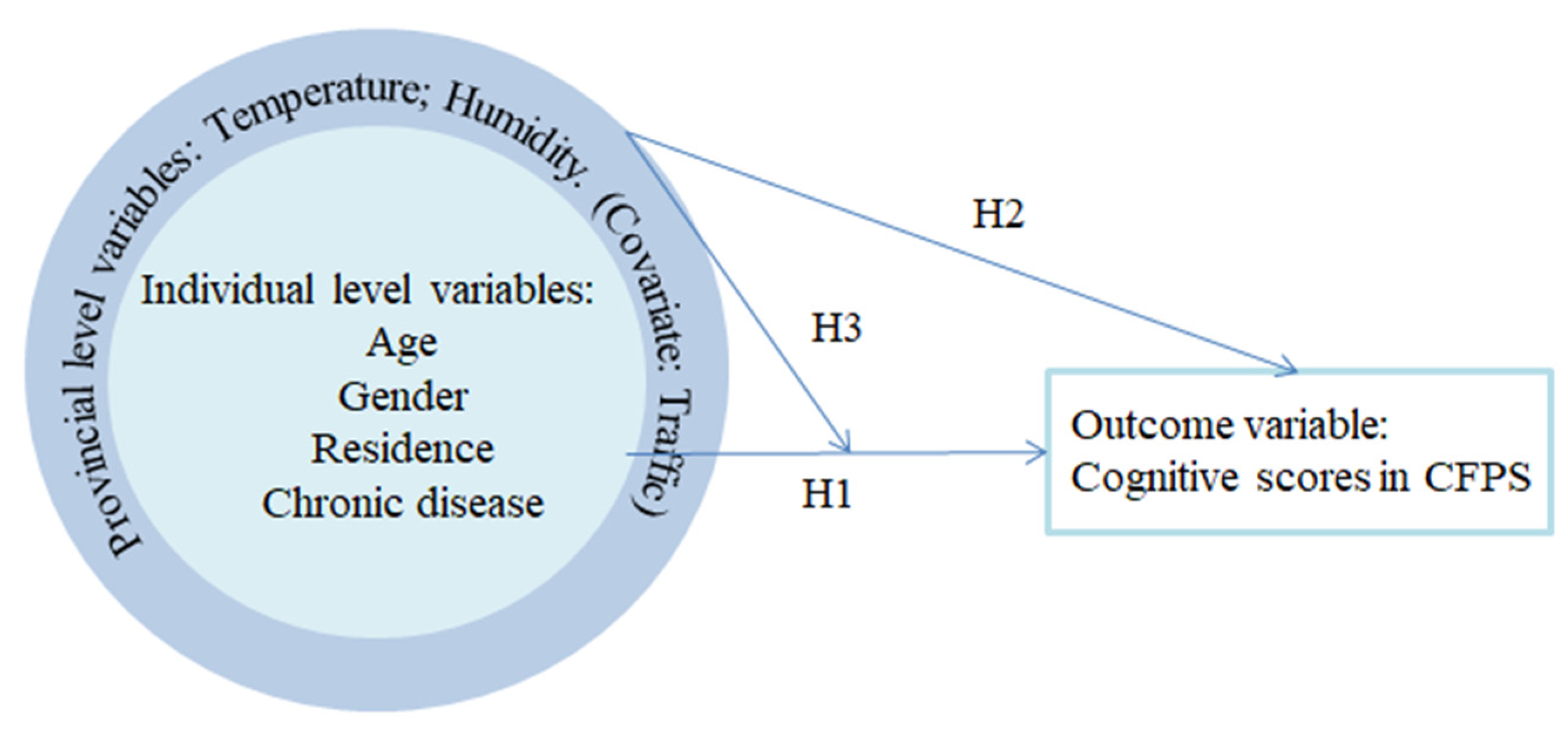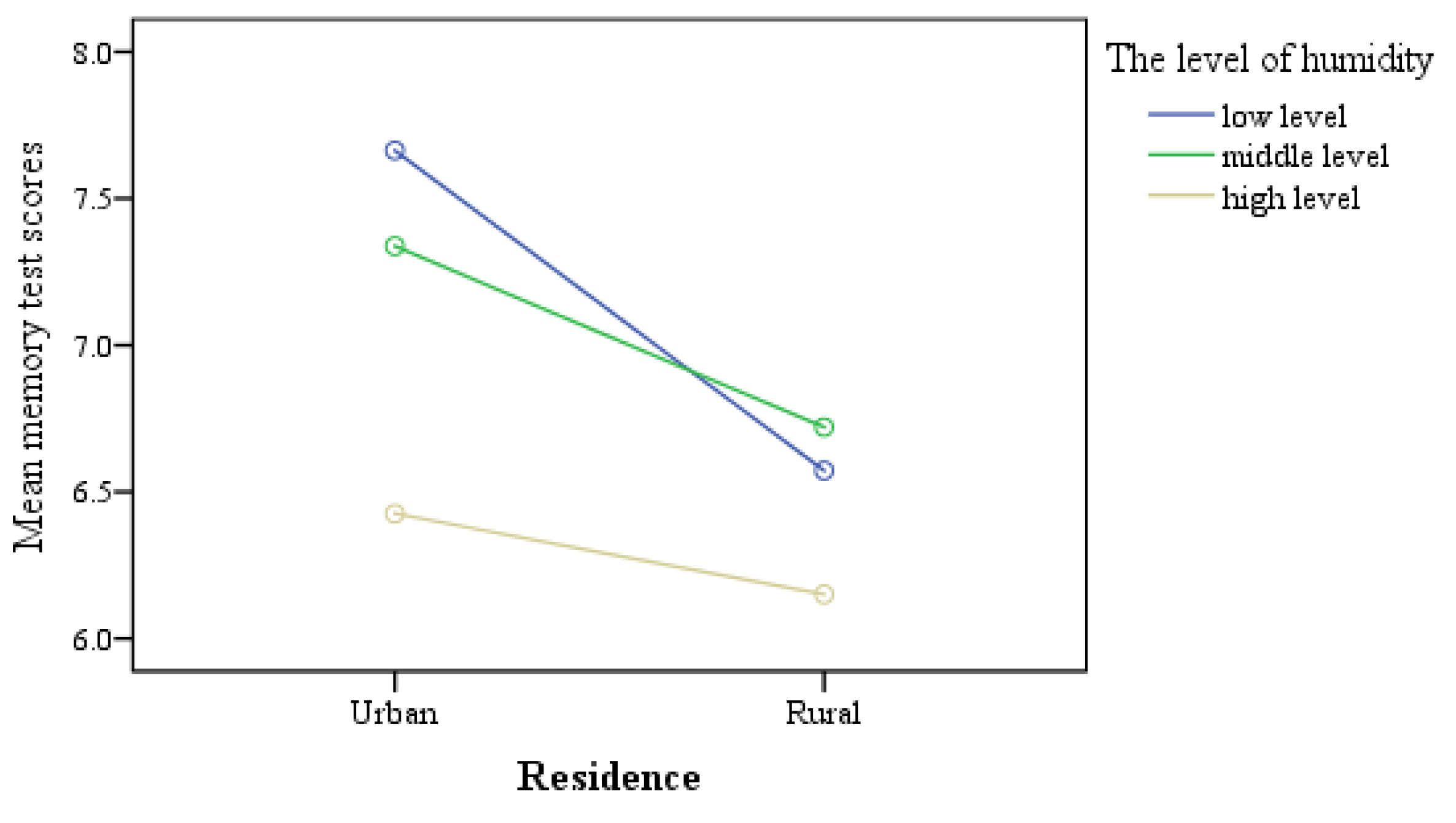1. Introduction
The aging population has rapidly increased worldwide. By 2050, the global population aged 60 years and older is expected to total 2 billion, up from 900 million in 2015 [
1]. Normal or pathological (e.g., mild cognitive impairment and Alzheimer’s disease) cognitive decline associated with aging is often accompanied by reduced quality of life [
2,
3,
4]. Moreover, cognitive impairment in older age has caused substantial financial and societal burdens. For example, direct and indirect costs for individuals with cognitive impairment have reached nearly
$244 billion annually worldwide [
5]. Thus, a better understanding of the factors that influence the speed of the cognitive decline over aging is warranted.
Multiple factors have been associated with cognitive function, such as age, gender, educational and nutritional level, socio-economic status, physical activity/sedentary behaviors, and chronic disease conditions. Some researchers have investigated the preventable effects of lifestyle behaviors (e.g., physical activity and prolonged sitting) on cognitive function in older age, showing that adopting healthy behaviors reduced the speed of the cognitive decline across aging [
6,
7,
8]. In addition to these individual and lifestyle risk factors, meteorological and environmental factors have also attracted scientific attention.
Previous studies have shown that environmental factors such as urbanization and traffic (e.g., highway construction) have been associated with cognitive function in older age [
9,
10,
11,
12]. For example, living in cities appears to reduce the risk of cognitive impairment, although the exact reasons are unclear [
12,
13]. This is not only because of the individual factors (e.g., higher occupational complexity) of urban elderly, notably, it has been suggested that the effect of this environmental factor on cognitive function can be explained by its influence on microclimate and ecology. Indeed, studies have shown that meteorological factors such as precipitation, sunshine, and other natural phenomena related to atmospheric movement may influence cognitive function [
14,
15,
16]. In particular, among these multiple meteorological indicators, temperature (i.e., air temperature) and humidity have been highlighted because they are thought to represent the most stable, common, and sensitive meteorological dimensions [
17,
18]. Other meteorological indicators such as ground temperature and atmospheric pressure are essentially following the variation of temperature and humidity, so they have serious multicollinearity problems. Therefore, it is meaningful to explore the influence of temperature and humidity on cognitive function in older age.
However, evidence of the associations of temperature and humidity with age-related cognitive decline is mixed. Some studies suggest that extreme (either cold or heat) temperature influences the rate of cognitive decline across aging (e.g., alertness, decision-making ability, and memory) [
19,
20]. However, other studies find no evidence of an association between temperature and cognitive function [
21,
22]. Moreover, some studies point out that humidity is a risk factor for the physiological and cognitive function in old age [
23,
24], but related research is still lacking. This lack of consistency may result from various factors. First, most studies have only investigated the influence of a single meteorological factor on cognitive function, which may have biased the associations observed. Second, study often relied on small sample sizes (n < 30) [
21,
22]. Third, the statistical approach used in previous studies (i.e., traditional regression model, which ignores the nesting of data, greatly reducing the practical significance of the research results) was not particularly suited to accurately estimate the associations between meteorological factors (i.e., a macro level factor) and cognitive functions (a micro level factor), while accounting for individual factors. It has been pointed out in the literature that meteorological factors, such as temperature and humidity, have different effects on demographic factors (e.g., gender and age) [
25,
26,
27]. Therefore, it is necessary to explore the interaction between meteorological factors and individual factors.
To fill this knowledge gap, the objective of the current study was to investigate, using an analytical strategy suited to examine the multiple levels of influence (i.e., micro and macro), the associations of temperature and relative humidity with the level of and change in cognitive function across aging. We used the monthly average temperature and relative humidity of each province in China to measure the meteorological factors. Cognitive functions were measured using cognitive tests. Age, gender, residence (urban or rural), and chronic disease (e.g., diabetes and hypertension) in older age were used as individual variables. In addition, as mentioned above, the traffic level influences people’s cognitive function through its impact on microclimate and ecology [
9,
10], and therefore, we use highway construction as a covariate.
We used a mixed model, as shown in
Figure 1, to test the hypotheses that the variables at the cross-level interactions had main and moderating effects on cognitive function in older age. We hypothesized that individual factors would be associated with cognitive function level and change across aging (H1a and H1b). Moreover, we hypothesized that temperature and humidity would be associated with cognitive function level and change across aging (H2a and H2b). Finally, we hypothesized that the association between individual factors and cognitive functions’ level of and change across aging would be moderated by temperature and humidity (H3a and H3b).
4. Discussion
In this study including 3448 older adults, we used mixed effects models and found that living in rural areas and high-level humidity areas were associated with lower memory test performance (
Table 7). Furthermore, we found that the strength of the negative association between the areas of residence and memory performance was moderated by humidity. In particular, this negative association was significantly more pronounced in urban areas compared to rural areas of residence. This study adds to the previous literature by revealing the association of individual and meteorological factors with cognitive function among older adults (
Table 8).
The moderating effect of humidity on the relationship between residence and memory function in older age was illustrated by the association between high level humidity and memory function of urban older adults. Whether living in urban or rural areas, the memory scores of the older adults in high-humidity areas were significantly lower. This result is consistent with the studies by Vasmatzidis et al. and Trezza et al., which found that the memory function of people acutely exposed to high humidity is significantly lower than that of people exposed to low humidity [
33,
34]. In addition to memory function, some studies have found that a high relative humidity (70%) environment (e.g., subtropical climate) can reduce the cognitive ability of individuals [
35], such as psychomotor speed and visual learning [
33,
35], making it more difficult for them to think clearly and reducing their alertness [
36]. This may be due to the influence of relative humidity on the body’s ability of thermal sensation and thermoregulation. High humidity reduces the evaporation of human sweat, resulting in greater heat stress, which leads to the decline of cognitive function [
33,
37]. Older adults are less adaptable to climate change [
38]. One possible explanation is that with adult aging, the regulatory capacity of older adults, such as cardiovascular function, gradually decreases, so the older adults are more vulnerable to the interference of heat stress [
26,
39]. Heat stress increases neuronal requirements for cognitive tasks in older adults [
40,
41] and disrupts brain functional connectivity [
42,
43]. Interestingly, we also found that the main effects of gender differences both in memory and logical sequence tests, which were consistent with previous views [
44]. Although no significant interaction between gender and meteorological factors was found in this study, some studies suggested that due to the different physiological structures of males and females (such as weight and surface area), the adaptability to meteorological factors was also different [
27,
45]. It reminds us that in future cognitive interventions for the elderly, different functions need to focus on different gender groups.
Importantly, in this study, we found that in high humidity, the memory scores of the older adults living in urban areas were significantly lower than those living in rural areas. Previous studies have provided a possible explanation that long-term exposure to air pollution (e.g., particulate matter) is associated with cognitive impairment in the elderly [
46,
47,
48]. Compared with rural areas, air pollution and other environmental problems in cities are more serious and meteorological factors such as high humidity play an important role in the elevation of air pollutant concentration [
49]. Previous studies have shown that the impact of traffic conditions on the microenvironment is related to the distance from the residence to the highway [
46]. This largely due to more intensive highway construction in cities; no matter in the design, construction, and operation stages, it will have a negative impact on the local micro ecological environment [
9]. Moreover, high humidity conditions are more likely to cause pollution of atmospheric particles [
50]. In addition, because of the urban heat island effect, a large number of studies have shown that in a high-heat and high-humidity environment, human cognitive function will be significantly reduced [
34,
35,
51].
However, in the logical sequence test, we found that the performance differences of the older adults in different provinces were not significantly related to meteorological factors, but more related to the individual factors (such as age, gender, etc.). The results of previous studies are not consistent. Some studies show that temperature is related to mathematical ability, while others have not [
52,
53,
54]. Another study points out that this inconsistency may be due to the lack of attention to gender differences in previous studies on temperature and mathematical ability [
25]. At present, the research on the relationship between meteorological factors and mathematical ability, especially for older adults, needs to be verified by follow-up studies.
In this study, we used a mixed model to test the correlation between meteorological factors and cognitive function of older adults, and also examined the micro and macro multi-level effects. The limitations of this study were that we mainly investigated the influence of temperature and humidity on the cognitive function of older adults, while atmospheric pressure, precipitation, and other meteorological variables, as well as the air quality and the degree of greening in the city would also have an impact on the local microclimate. The meteorological data used in this study was accurate to the month, and we conceptualized the effects of humidity on cognitive outcomes as a contributor to a more chronic process of cognitive decline. In future research, using longitudinal datasets will help us to compare the acute exposure and cumulative effects of meteorological factors on cognitive function. In addition, we could further investigate the comprehensive effects of climate, environment, and ecology, using socio-economic status, formal education, home, and work environments (i.e., whether outfitted with air conditioners and dehumidifiers) as covariates or predictors in the equations to predict cognitive differences and report more accurate results.








